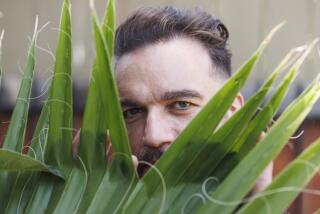Basking in NPR’s Garden Party
- Share via
It was safe and secure in the garden, which was separated from the street by a high, red brick wall covered with ivy, and not even the sounds of the passing cars disturbed the peace.
--Chance the gardener in Jerzy Kosinski’s “Being There”
A 30-acre orange grove. A Mediterranean garden. A native plant preserve. Two rose gardens. A courtyard.
All of it to die for, right?
What a fertile spread actor Peter Strauss has in Ojai. I was on a gridlocked freeway, sealed inside my air-conditioned car, when I visited it.
While listening to NPR’s “Morning Edition” on KCRW-FM (89.9).
It was mesmerizing.
Who would have thought that radio could be such a greenhouse for cultivating and nurturing esteem for horticulture? The sounds of gardens? A rose that can be heard? Leaves traveling the airwaves? Get outta here. Everyone knows that plants and flowers can’t be fully appreciated without pictures. In mass media, that means television.
Nope. Those six minutes on Strauss and his greenery came in “Celebrity Gardens,” a much-too-fleeting NPR series that affirmed just how vividly picturesque radio can be. As with Strauss’ impressive family of cacti sporting “bulbous mounds and towering flower stalks 20 feet high.”
Speaking was Ketzel Levine, the smart and witty NPR gardening maven whose colleagues have anointed her “the Doyenne of Dirt.” Credit for these four weekly segments goes to Levine and her subjects, who also included writer T.C. Boyle and actor John Spencer (White House Chief of Staff Leo McGarry in NBC’s “West Wing”), as well as the famed Lotusland gardens in Montecito.
“Celebrity Gardens” was a good match for NPR, which itself has been a verdant green zone in the largely burnt-out landscape of broadcasting. More than likely, moreover, television would have wilted “Celebrity Gardens” and its flowering imagery whose run ended Friday.
Deep affection is easily mocked, and on the small screen can translate to unhealthy fixation. One can imagine a local TV reporter lifting a skeptical brow at the lens, for example, when Boyle spoke joyfully of hauling rocks and digging holes as part of the “restoration ecology” he practices at his Montecito place. What, is he weird or something?
The magic of radio, in contrast, is that listeners ultimately must supply their own pictures, in this case with assistance from Levine, who has a way with words.
She was blunt. “How long has this dead cactus-looking thing been here?” she chided the self-effacing Spencer in his Bel-Air garden, where he is so devoted to even his terminal plants that euthanizing just one is unthinkable.
She was eloquent, as when describing the “white peeling bark and the sun hitting the leaves” of Boyle’s thickening forest of eucalyptus trees.
Always, she was fun. In Levine’s eyes, Spencer’s patio was a “hospice for roses.” Observing Boyle’s unruly plants, she found him to be less a gardener than a “referee.” While touring this writer’s “suburban amazonia,” she noted that he and his plantings shared “unkempt looks and a slight sense of foreboding” that were “remarkably out of place in this cut-and-blow-dried town.”
Visiting fancy shmancy neighborhoods assured that NPR listeners would hear only from gardeners with budgets taller than Strauss’ cacti. It would be refreshing to hear also from members of the underclass who tend their smaller patches with as much tenderness as the rich.
But the basics, and the total emersion of gardeners described by the series, are universal.
Although intellectually dim, Kosinski’s hero in “Being There” understood that “plants were like people; they needed care to live, to survive their diseases, and to die peacefully.” Metaphorically, the brick wall enclosing his garden surrounds gardeners everywhere, blocking the larger, more shrill outside world from invading the serenity of their microcosmic universe.
That applies not just to green thumbs, but also to schlubs like yours truly whose gardening, however much we try our best, contributes to the browning of America. Although all of us don’t have the touch, gardening is one of life’s common denominators.
So we all understood when Boyle said that physical labor on behalf of plants “numbs my mind.” And understood when Spencer called gardening an activity in which “I can literally zone out.”
Said Levine: “It’s not about perfect plants with John Spencer, it’s about gardening.”
What I especially enjoyed was the segment describing Strauss’ metamorphoses from native New Yorker to hooked-on-green Southern Californian. His “botanic paradise” is more than a garden, Levine said. “It’s a planned community inhabited by thousands, each with its own specific demands.”
Who would have predicted it? After all, here was this guy from an urban slab where, Levine quoted photographer Annie Leibovitz as observing, “outside is what you pass through to get into a cab.” Yet one visit to the Santa Monica Succulent Society, said Levine, “and the next thing he knows he’s a dues-paying member off to Baja, on his hands and knees looking for cacti the size of a dime.”
Three decades later, he’s passing through the rose gardens to get into the orange grove.
Levine called gardening his “role of a lifetime,” and Strauss said he’s often contemplated giving up acting (he probably remains most famous for starring in ABC’s two “Rich Man, Poor Man” miniseries) to do it full-time.
A gardener’s work, he noted, “is never done.”
“Celebrity Gardens” is, sadly. A rose snipped before its time.
*
Howard Rosenberg’s column appears Mondays, Wednesdays and Fridays. He can be contacted via e-mail at [email protected]. For the remainder of this week, Rosenberg’s column will appear daily with The Times’ coverage of the Republican National Convention in Philadelphia.
More to Read
The complete guide to home viewing
Get Screen Gab for everything about the TV shows and streaming movies everyone’s talking about.
You may occasionally receive promotional content from the Los Angeles Times.






